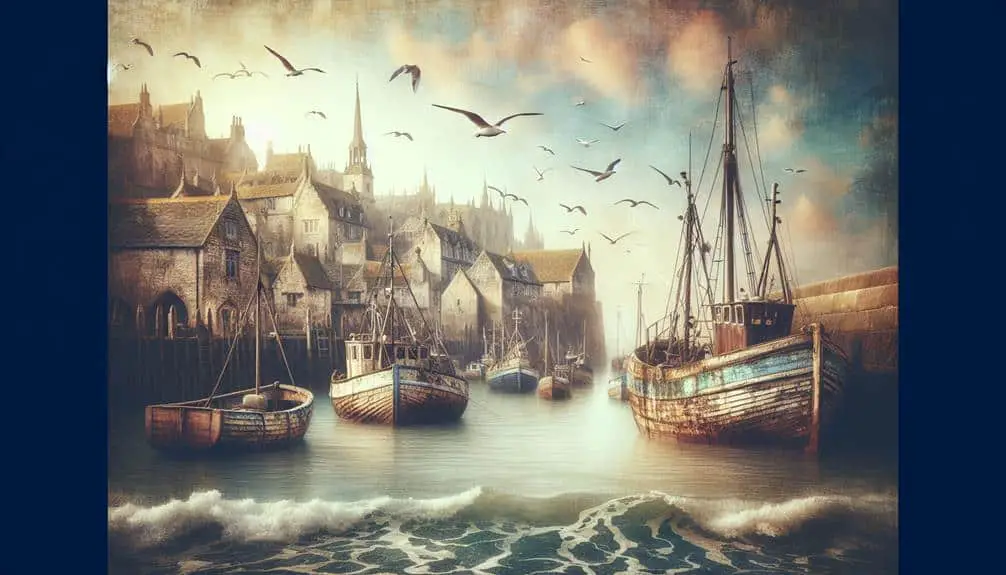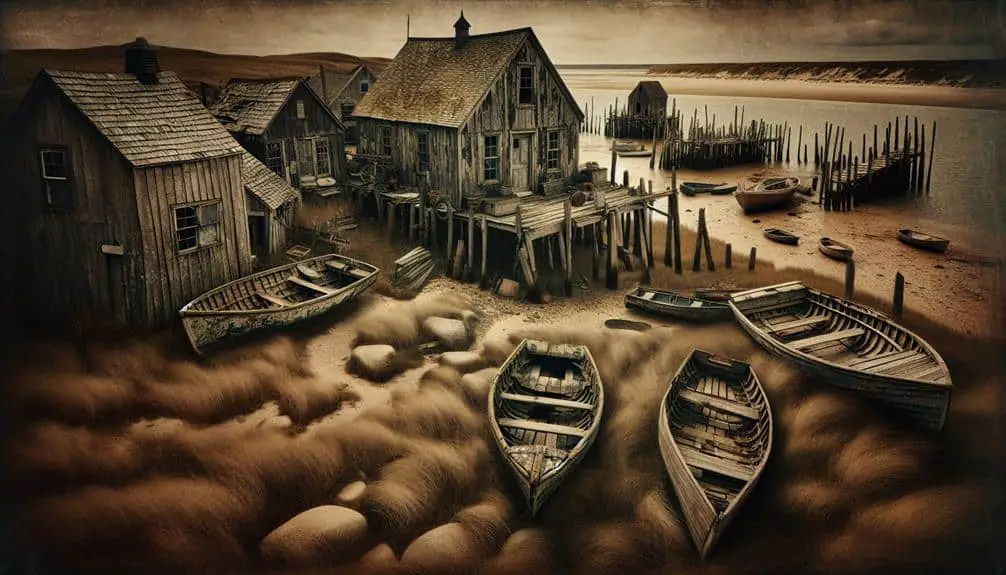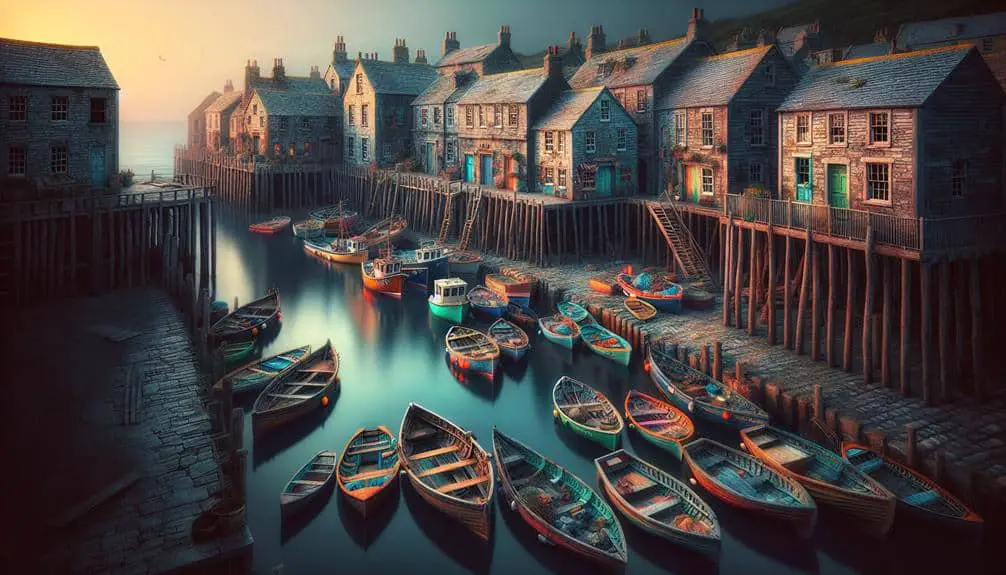Discover the remnants of coastal fishing village vestiges: neglected piers, weathered warehouses, and crumbling boathouses stand as echoes of a bygone era. These structures reflect the impact of time and the changing tides on maritime communities. Each relic tells a story of resilience and human connection to the sea, offering a glimpse into the challenges faced by traditional fishermen. By exploring these vestiges, you can unravel the rich history and cultural heritage intertwined with the coastal landscape, hinting at the intricate tapestry of coastal life waiting to be uncovered.
Key Points
- Abandoned waterfront structures like piers and boathouses depict a bygone era of coastal fishing villages.
- Fishery artifacts serve as tangible links to the past, showcasing craftsmanship and resilience.
- Neglected relics bear scars of coastal erosion, impacting ecosystems and cultural heritage.
- Preservation efforts focus on meticulous conservation and restoration of fishing village relics.
- Tourism influences the cultural landscape and preservation of coastal fishing village vestiges.
Decline of Traditional Fishing Practices
The traditional fishing practices in the coastal fishing village have dwindled considerably over the past few decades, primarily due to technological advancements and shifting economic priorities. Modern technology, such as mechanized boats and sonar equipment, has replaced the once labor-intensive methods of hand-casting nets and sail-powered vessels. While these innovations have increased efficiency and productivity, they've also led to a decline in the intimate connection between fishermen and the sea.
With the rise of industrialized fishing practices, concerns for environmental conservation have taken a back seat. Overfishing and destructive fishing methods have depleted marine resources and harmed delicate ecosystems. The balance between sustainable harvesting and profit-driven exploitation has tipped in favor of short-term gains, neglecting the long-term health of the ocean.
As the allure of modernity continues to reshape coastal communities, it's imperative to find a harmonious coexistence between technological advancements and environmental stewardship. Preserving the heritage of traditional fishing practices while embracing innovations that prioritize sustainability is essential to safeguard the legacy of coastal villages for generations to come.
Abandoned Waterfront Structures
Abandoning the traditional fishing methods hasn't only altered the livelihoods of coastal villagers but has also left behind a haunting legacy of neglected waterfront structures. These once vibrant hubs of fishing activity now stand as silent witnesses to the passage of time, bearing the scars of coastal erosion and architectural decay. The abandoned piers, dilapidated warehouses, and crumbling boathouses paint a solemn picture of a bygone era when the sea was a source of sustenance and livelihood for the community.
The environmental impact of these abandoned structures can't be overlooked. With each passing year, the structural integrity of these waterfront buildings weakens, posing a threat to the surrounding ecosystem. However, amidst the bleak landscape of neglect, there's hope for environmental restoration through community engagement. By involving local residents in the preservation and restoration efforts, these abandoned waterfront structures can be revitalized, breathing new life into the coastal village and preserving its historical significance for future generations.
Historical Significance of Fishery Artifacts
Amidst the remnants of coastal fishing villages lie a treasure trove of fishery artifacts that bear witness to the historical significance of traditional fishing practices. These artifacts, ranging from fishing tools like nets, hooks, and traps to remnants of boats and storage facilities, serve as tangible links to the past. Through archaeological discoveries, researchers have uncovered how these artifacts were integral to the daily lives of fishing communities, shedding light on their methods, skills, and adaptations to the coastal environment.
The cultural heritage embedded in these artifacts is profound, showcasing the craftsmanship and ingenuity of past generations. Each artifact tells a story of resilience, innovation, and symbiosis with the sea. By studying these remnants, we gain a deeper understanding of the challenges and triumphs faced by coastal fishing communities throughout history.
Preserving these fishery artifacts isn't only for their historical value but also for safeguarding an essential part of our cultural heritage. Through continued research and conservation efforts, we can safeguard that the legacy of coastal fishing villages endures for future generations to appreciate and learn from.
Preservation Efforts for Fishing Village Relics
Preserving the relics of coastal fishing villages requires meticulous conservation efforts to safeguard their cultural significance and historical legacy. These efforts often involve restoration projects aimed at maintaining the authenticity of the artifacts while ensuring their longevity for future generations to appreciate. By actively participating in the preservation of these remnants, you contribute to the protection of an important part of our cultural heritage.
Restoration projects play an important role in ensuring that fishing village relics remain intact and accessible to the public. Through careful restoration work, experts can repair damages caused by time and environmental factors, allowing these artifacts to tell their stories for years to come. By supporting such initiatives, you actively engage in the conservation of our shared history.
The preservation of fishing village relics is essential not only for maintaining our cultural heritage but also for understanding the evolution of coastal communities. Your involvement in restoration projects can help revitalize these historical sites, ensuring that their significance isn't lost to time. Embrace the opportunity to contribute to the preservation of our past through the conservation of fishing village relics.
Impact of Tourism on Coastal Villages
Tourism's impact on coastal villages has been a pivotal force shaping the cultural landscape and socioeconomic dynamics of these communities. As travelers flock to these picturesque settings, the delicate balance between preservation and development is tested. The influx of tourists brings economic opportunities but also challenges the environmental conservation efforts and the safeguarding of cultural heritage.
The surge in tourism can strain natural resources, leading to issues like pollution and habitat degradation. Coastal villages often face the dilemma of catering to visitors' needs while preserving the fragile ecosystems that define their identity. Balancing the demands of tourism with environmental conservation is essential to guarantee the long-term sustainability of these communities.
Furthermore, the influx of tourists can influence the preservation of cultural heritage. As visitors seek authentic experiences, there's a risk of commodifying traditions and eroding the genuine essence of coastal village life. Striking a balance between promoting cultural heritage and preventing its exploitation is vital to maintain the unique charm and authenticity of these coastal communities.
Frequently Asked Questions
How Did the Decline of Traditional Fishing Practices Impact the Cultural Identity of the Coastal Fishing Village?
As traditional fishing practices declined, the cultural impact on the coastal fishing village was profound. Your identity, rooted in generations of seafaring traditions, faced erasure, leaving a void once filled with vibrant customs and deep connections.
What Are Some Unique Features of the Abandoned Waterfront Structures in the Village That Make Them Stand Out From Other Coastal Areas?
Explore the abandoned waterfront structures in the village. Discover unique architectural details like weathered beams and faded murals. Conservation practices aim to preserve these vestiges. Artistic elements intertwine with the environment, telling stories of the past.
Are There Any Famous Fishery Artifacts With a Significant Historical Significance That Have Been Preserved in the Village?
In the village, notable fishery artifacts hold rich historical significance. Some have been preserved due to environmental conservation efforts. Impact of globalization on these relics is evident, reflecting a blend of tradition and modernity.
What Specific Preservation Efforts Have Been Made to Protect and Maintain the Fishing Village Relics for Future Generations?
To preserve the fishing village relics for future generations, diligent preservation efforts have been undertaken. These initiatives not only safeguard the cultural heritage but also enhance tourism impact, ensuring the village's historical significance endures.
How Has the Increase in Tourism Affected the Local Community and Environment of the Coastal Village?
When tourists swarm to your coastal village, economic impact can be substantial. Guarantee community development aligns with environmental conservation for sustainable tourism. Balancing prosperity with nature preservation is essential for long-term well-being.



